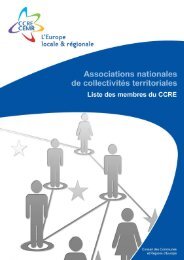1 Introducti<strong>on</strong> >2 Demographic Changes in Europe > 3 Demographic Change in Four Policy fields > 4 Summary <strong>and</strong> C<strong>on</strong>clusi<strong>on</strong>> 5 Further Inquiry <strong>and</strong> Research Questi<strong>on</strong>s > 6 <str<strong>on</strong>g>The</str<strong>on</strong>g> Council <str<strong>on</strong>g>of</str<strong>on</strong>g> European Municipalities <strong>and</strong> Regi<strong>on</strong>s in a nutshellLower fertility rates lead to fewer children dem<strong>and</strong>ing socialservices. This means that day care instituti<strong>on</strong>s (schools,kindergartens) are underutilized <strong>and</strong> will no l<strong>on</strong>ger functi<strong>on</strong>efficiently. Child care <strong>and</strong> educati<strong>on</strong>al facilities mayc<strong>on</strong>sequently be reduced in size, <strong>and</strong> some may have to close.Schools <strong>and</strong> child care instituti<strong>on</strong>s are experiencing similardevelopments. In these sectors services will presumably bereduced in the coming years.<str<strong>on</strong>g>The</str<strong>on</strong>g>se opposing trends will develop even more dramatically insparsely populated areas. In these <str<strong>on</strong>g>of</str<strong>on</strong>g>ten peripheral, ruralareas, distances are already great. An ageing <strong>and</strong> shrinkingpopulati<strong>on</strong> (for instance in some parts <str<strong>on</strong>g>of</str<strong>on</strong>g> eastern Germany ornorthern Finl<strong>and</strong>) will exacerbate the problems involved inadjusting infrastructure to meet the changing dem<strong>and</strong> <str<strong>on</strong>g>of</str<strong>on</strong>g>different groups.General strategies (38) under discussi<strong>on</strong> for adjustinginfrastructure supply in rural/peripheral regi<strong>on</strong>s experiencingstr<strong>on</strong>g populati<strong>on</strong> decline include:• Improving accessibility: This enlarges the catchment area<strong>and</strong> makes the infrastructure available to more people.<str<strong>on</strong>g>The</str<strong>on</strong>g> efficiency <str<strong>on</strong>g>of</str<strong>on</strong>g> instituti<strong>on</strong>s can be enhanced even if theinstituti<strong>on</strong> itself remains un<str<strong>on</strong>g>change</str<strong>on</strong>g>d (e.g., optimized publictransport networks, dem<strong>and</strong>-adapted bus timetables).• Diminishment: <str<strong>on</strong>g>The</str<strong>on</strong>g> supply <str<strong>on</strong>g>of</str<strong>on</strong>g> social infrastructure toresidents or the instituti<strong>on</strong> itself is reduced to the sizerequired by decreased dem<strong>and</strong>. <str<strong>on</strong>g>The</str<strong>on</strong>g> catchment area <str<strong>on</strong>g>of</str<strong>on</strong>g> usersremains the same or may decrease (e.g., reduced routesystem for buses).• Decentralisati<strong>on</strong>: Splitting infrastructure into smaller, betterorganizedunits can improve the efficiency <str<strong>on</strong>g>of</str<strong>on</strong>g> distributi<strong>on</strong>.Especially for technical infrastructure, decentralisati<strong>on</strong> is aneffective means <str<strong>on</strong>g>of</str<strong>on</strong>g> overcoming high network c<strong>on</strong>necti<strong>on</strong>costs (e.g., <strong>local</strong> ecological sewage plants).• Centralisati<strong>on</strong>: Pooling inefficient <strong>and</strong> underutilized secti<strong>on</strong>sto c<strong>on</strong>nect with a centralized supply <str<strong>on</strong>g>of</str<strong>on</strong>g> infrastructureincreases cost-effectiveness. This centralisati<strong>on</strong> approachmust be paired with accessibility improvements within theenlarged catchment area (e.g., the merging <str<strong>on</strong>g>of</str<strong>on</strong>g> schools insparsely populated areas complemented by a school bussystem ensuring accessibility).• Temporary-mobile approaches: Periphery regi<strong>on</strong>s are<str<strong>on</strong>g>of</str<strong>on</strong>g>ten unable to maintain permanently stati<strong>on</strong>ed support<str<strong>on</strong>g>of</str<strong>on</strong>g> services. High costs are linked to inefficient use (e.g.,mobile libraries, farmers markets <strong>and</strong> “<strong>local</strong> visiting hours”).• Restructuring/substituti<strong>on</strong> <str<strong>on</strong>g>of</str<strong>on</strong>g> infrastructure: Tasks arecompleted in new ways <strong>and</strong> functi<strong>on</strong>s performed by differentinstituti<strong>on</strong>s (e.g., ordering products via Internet, the use <str<strong>on</strong>g>of</str<strong>on</strong>g><strong>local</strong> taxis as an alternative to an extensive public transportsystem).In adjusting the social services system to counter <str<strong>on</strong>g>of</str<strong>on</strong>g> the <str<strong>on</strong>g>impact</str<strong>on</strong>g><str<strong>on</strong>g>of</str<strong>on</strong>g> <str<strong>on</strong>g>demographic</str<strong>on</strong>g> <str<strong>on</strong>g>change</str<strong>on</strong>g> two financial aspects need tobe addressed: reducing services to save m<strong>on</strong>ey <strong>on</strong> theexpenditure side (see above), <strong>and</strong> raising the statutoryretirement age or <str<strong>on</strong>g>of</str<strong>on</strong>g> the public share <str<strong>on</strong>g>of</str<strong>on</strong>g> social service costs <strong>on</strong>the revenue side <str<strong>on</strong>g>of</str<strong>on</strong>g> the system.Local <strong>and</strong> regi<strong>on</strong>al <strong>government</strong> are called up<strong>on</strong> to take acti<strong>on</strong>because providing, managing, <strong>and</strong> sometimes even fundingsocial services is in different ways a municipal task in allcountries under study. In the Czech Republic, most socialservice facilities <strong>and</strong> instituti<strong>on</strong>s are administered by regi<strong>on</strong>s<strong>and</strong> municipalities (39) . In Finl<strong>and</strong>, <strong>local</strong> authorities providechild day-care, welfare for the aged <strong>and</strong> the disabled, <strong>and</strong> awide range <str<strong>on</strong>g>of</str<strong>on</strong>g> other social services (40) – as in Germany, wheren<strong>on</strong>-pr<str<strong>on</strong>g>of</str<strong>on</strong>g>it organisati<strong>on</strong>s also play an important role <strong>on</strong> behalf<str<strong>on</strong>g>of</str<strong>on</strong>g> the municipality. Thus, it is <strong>local</strong> <strong>and</strong> regi<strong>on</strong>al <strong>government</strong>that will have to adjust the quality <strong>and</strong> extent <str<strong>on</strong>g>of</str<strong>on</strong>g> socialservices. Furthermore, they may be obliged to find new modesfor social services. For instance, since there are fewer childrenbut more elderly <strong>and</strong> very old singles, traditi<strong>on</strong>al modes <str<strong>on</strong>g>of</str<strong>on</strong>g>family care (chiefly the resp<strong>on</strong>sibility <str<strong>on</strong>g>of</str<strong>on</strong>g> daughters or wives)will be replaced by instituti<strong>on</strong>alised, pr<str<strong>on</strong>g>of</str<strong>on</strong>g>essi<strong>on</strong>al forms <str<strong>on</strong>g>of</str<strong>on</strong>g>care, provided by either public or private (commercial <strong>and</strong>n<strong>on</strong>-pr<str<strong>on</strong>g>of</str<strong>on</strong>g>it) facilities.Activities <strong>and</strong> reacti<strong>on</strong> strategies:examples from the 4 countries<str<strong>on</strong>g>The</str<strong>on</strong>g> challenges that <str<strong>on</strong>g>demographic</str<strong>on</strong>g> <str<strong>on</strong>g>change</str<strong>on</strong>g>s pose for socialservices can be illustrated by c<strong>on</strong>crete projects from severalmunicipalities.<str<strong>on</strong>g>The</str<strong>on</strong>g> “all-day school experiment” in some Finnish municipalities(e.g. Jyvöskylä, pop. 50,000) aims to supplement ordinaryschool activities by supervised hobby <strong>and</strong> leisure activities forschoolchildren. <str<strong>on</strong>g>The</str<strong>on</strong>g> programme is free <str<strong>on</strong>g>of</str<strong>on</strong>g> charge to theparents.<str<strong>on</strong>g>The</str<strong>on</strong>g> project will take two years <strong>and</strong> is being carried outin cooperati<strong>on</strong> with the University <str<strong>on</strong>g>of</str<strong>on</strong>g> Jyväskylä. A special aim<str<strong>on</strong>g>of</str<strong>on</strong>g> the project is to reduce the threat that l<strong>on</strong>ely evenings posefor pupils' development. <str<strong>on</strong>g>The</str<strong>on</strong>g> <str<strong>on</strong>g>change</str<strong>on</strong>g>s in the structure <str<strong>on</strong>g>of</str<strong>on</strong>g> the(38) Even if the following strategies were developed for rural areas in eastern Germany they should be transferable to other regi<strong>on</strong>s with similar spatial <strong>and</strong> <str<strong>on</strong>g>demographic</str<strong>on</strong>g> c<strong>on</strong>texts (Cf. Bundesamt für Bauwesenund Raumordnung (BBR), Anpassungsstrategien für ländliche/periphere Regi<strong>on</strong>en mit starkem Bevölkerungsrückgang in den neuen Ländern, (Heft 38) B<strong>on</strong>n, 2005).(39) Ministry <str<strong>on</strong>g>of</str<strong>on</strong>g> Labour <strong>and</strong> Social Affairs (2004), Nati<strong>on</strong>al Acti<strong>on</strong> Plan <strong>on</strong> Social Inclusi<strong>on</strong> 2004-2006, Czech Republic (http://europa.eu.int/comm/employment_social/soc-prot/soc-incl/nap_incl_2004_cz_en_versi<strong>on</strong>.pdf).(40) Associati<strong>on</strong> <str<strong>on</strong>g>of</str<strong>on</strong>g> Finnish Local <strong>and</strong> Regi<strong>on</strong>al Authorities; http://www.kunnat.net.
1 Introducti<strong>on</strong> >2 Demographic Changes in Europe > 3 Demographic Change in Four Policy fields > 4 Summary <strong>and</strong> C<strong>on</strong>clusi<strong>on</strong>> 5 Further Inquiry <strong>and</strong> Research Questi<strong>on</strong>s > 6 <str<strong>on</strong>g>The</str<strong>on</strong>g> Council <str<strong>on</strong>g>of</str<strong>on</strong>g> European Municipalities <strong>and</strong> Regi<strong>on</strong>s in a nutshellschool day envisaged in the project are expected to improvethe general atmosphere at school <strong>and</strong> the pupils' well-being.Six schools – in Jyväskylä, Kuopio, Sievi <strong>and</strong> Sipoo – areinvolved in the project. In these schools, the pupils' workingday is made more relaxed by inserting supervised hobby <strong>and</strong>outdoor activities between less<strong>on</strong>s <strong>and</strong> after school hasfinished. <str<strong>on</strong>g>The</str<strong>on</strong>g> pupils also enjoy a l<strong>on</strong>ger lunch break. In this waythe time the pupils spend al<strong>on</strong>e at home is reduced <strong>and</strong> theyalso have the opportunity to take part in different hobbies <strong>and</strong>sports regardless <str<strong>on</strong>g>of</str<strong>on</strong>g> their parents' income. <str<strong>on</strong>g>The</str<strong>on</strong>g> all-day schoolproject is being carried out as a part <str<strong>on</strong>g>of</str<strong>on</strong>g> the larger MUKAVAproject, which includes various sub-projects designed tosupport young people's growing up <strong>and</strong> their development inthe school world. <str<strong>on</strong>g>The</str<strong>on</strong>g> MUKAVA project is being financed byleading Finnish companies.<str<strong>on</strong>g>The</str<strong>on</strong>g> Heilbr<strong>on</strong>n-Franken regi<strong>on</strong> (state <str<strong>on</strong>g>of</str<strong>on</strong>g> Baden-Wuerttemberg,Germany) has initiated a pilot project “Child-friendly Regi<strong>on</strong>”together with different partners. <str<strong>on</strong>g>The</str<strong>on</strong>g> regi<strong>on</strong> has developedmeasures to improve <strong>local</strong> <strong>and</strong> regi<strong>on</strong>al c<strong>on</strong>diti<strong>on</strong>s for familiesthat create a “pro-family climate” <strong>and</strong> facilitate the compatibility<str<strong>on</strong>g>of</str<strong>on</strong>g> family <strong>and</strong> work, with the goal <str<strong>on</strong>g>of</str<strong>on</strong>g> encouraging peopleto have children. Child-friendliness in a community includesa broad range <str<strong>on</strong>g>of</str<strong>on</strong>g> measures c<strong>on</strong>cerning housing <strong>and</strong>neighbourhoods, transport, leisure activities, educati<strong>on</strong>,childcare, meeting points, culture, <strong>and</strong> ec<strong>on</strong>omic c<strong>on</strong>diti<strong>on</strong>s.Activities include a model kindergarten in cooperati<strong>on</strong> withthe Academy for Informati<strong>on</strong> <strong>and</strong> Management (AIM).<str<strong>on</strong>g>The</str<strong>on</strong>g> focus is <strong>on</strong> educati<strong>on</strong> for very young children <strong>and</strong>adequate training for kindergarten teachers. Another project ischild-friendly planning for a residential area, a third a“part-time educati<strong>on</strong>” project that <str<strong>on</strong>g>of</str<strong>on</strong>g>fers women with childrena better opportunity to re-enter the labour market. <str<strong>on</strong>g>The</str<strong>on</strong>g> projectis financed by regi<strong>on</strong>al partners, the Federal Ministry<str<strong>on</strong>g>of</str<strong>on</strong>g> Transport <strong>and</strong> Spatial Planning <strong>and</strong> the Federal Ministry <str<strong>on</strong>g>of</str<strong>on</strong>g>Families, Seniors, Women <strong>and</strong> Youth.<str<strong>on</strong>g>The</str<strong>on</strong>g> aim <str<strong>on</strong>g>of</str<strong>on</strong>g> the project “A City for All – Barrier-FreeEnvir<strong>on</strong>ment” in Marjala, a neighbourhood <str<strong>on</strong>g>of</str<strong>on</strong>g> Joensuu(pop. 58,000, Finl<strong>and</strong>), is to design all dwellings to meet theneeds <str<strong>on</strong>g>of</str<strong>on</strong>g> the wheelchair-bound or otherwise disabled. All basicdimensi<strong>on</strong>s, such as the width <str<strong>on</strong>g>of</str<strong>on</strong>g> the doors, corridors <strong>and</strong> lifts,allow for wheelchair access, <strong>and</strong> any <str<strong>on</strong>g>of</str<strong>on</strong>g> the homes can beeasily adapted to the individual needs <str<strong>on</strong>g>of</str<strong>on</strong>g> a disabled resident.Furthermore, the provisi<strong>on</strong> <str<strong>on</strong>g>of</str<strong>on</strong>g> different services in the areais based <strong>on</strong> innovative partnerships <strong>and</strong> use <str<strong>on</strong>g>of</str<strong>on</strong>g> moderntechnology put at the service <str<strong>on</strong>g>of</str<strong>on</strong>g> residents. A computerizedMultiservice channel – PALVELUELLI – was developed to linkall service providers. <str<strong>on</strong>g>The</str<strong>on</strong>g> Multiservice channel can be accessedfrom either home computers or the Multiservice Centre.Through the Multiservice channel, residents can seek expertadvice (c<strong>on</strong>tact the family doctor), communicate with otherresidents, or discuss municipal affairs with political decisi<strong>on</strong>makers. An increasing number <str<strong>on</strong>g>of</str<strong>on</strong>g> the disabled will c<strong>on</strong>tinueliving at home. <str<strong>on</strong>g>The</str<strong>on</strong>g>refore when the layout, infrastructure <strong>and</strong>buildings in Marjala were designed, much attenti<strong>on</strong> was paidto the needs <str<strong>on</strong>g>of</str<strong>on</strong>g> people returning to the "normal" livingenvir<strong>on</strong>ment after l<strong>on</strong>g spells in care instituti<strong>on</strong>s <strong>and</strong> to theways in which their return to the "ordinary" community couldbe facilitated (41) .<str<strong>on</strong>g>The</str<strong>on</strong>g> “Self-determined housing for elderly people” project inthe German city <str<strong>on</strong>g>of</str<strong>on</strong>g> Brunswick (pop. 245,000) has a similarfocus.Anticipating greater dem<strong>and</strong> for in-patient infrastructure,the municipality supports the initiative <str<strong>on</strong>g>of</str<strong>on</strong>g> the ambet e.V.associati<strong>on</strong> to provide group homes for the elderly as analternative to retirement homes. In general 3 to 5 seniorcitizens live together in a household, all with separate living<strong>and</strong> bedrooms. Each group is supervised by a qualified socialeducati<strong>on</strong> worker <strong>and</strong> is assisted by a home help. Even ifresidents require intensive geriatric care, they may remainin their housing group. Joint quality management bymunicipality <strong>and</strong> associati<strong>on</strong> guarantees st<strong>and</strong>ards. <str<strong>on</strong>g>The</str<strong>on</strong>g>resdents pay for these services, but the costs are lowercompared to retirement homes. Furthermore, nursing careinsurance costs are below costs for “traditi<strong>on</strong>al” in-patientaccommodati<strong>on</strong>.<str<strong>on</strong>g>The</str<strong>on</strong>g> project “TEL LAPPI – Telemedicine in Lapl<strong>and</strong>” (Sodankylä,pop. less than 10,000, rural northern Finl<strong>and</strong>) explicitly servesrural areas with sparse populati<strong>on</strong>. Health care services can beprovided by means <str<strong>on</strong>g>of</str<strong>on</strong>g> modern informati<strong>on</strong> technology.<str<strong>on</strong>g>The</str<strong>on</strong>g> object <str<strong>on</strong>g>of</str<strong>on</strong>g> telemedicine is to transfer informati<strong>on</strong> aboutthe patient instead <str<strong>on</strong>g>of</str<strong>on</strong>g> the patient himself, as well as to <str<strong>on</strong>g>of</str<strong>on</strong>g>ferhealth care centres special health care services by means<str<strong>on</strong>g>of</str<strong>on</strong>g> informati<strong>on</strong> technology. Distance c<strong>on</strong>sultati<strong>on</strong> <strong>and</strong> atraining system based <strong>on</strong> videoc<strong>on</strong>ferencing technology aim topromote <strong>and</strong> develop co-operati<strong>on</strong> between specialised <strong>and</strong>basic health care. Informati<strong>on</strong> technology makes it possible toalleviate problems caused by l<strong>on</strong>g distances.<str<strong>on</strong>g>The</str<strong>on</strong>g> German project “Centralised Health Care Centres” in thestate <str<strong>on</strong>g>of</str<strong>on</strong>g> Mecklenburg-Vorpommern (rural area, East Germany)also focuses <strong>on</strong> medical services in sparsely populated areas.(41) Management <str<strong>on</strong>g>of</str<strong>on</strong>g> Social Transformati<strong>on</strong> (MOST), Best practices for human settlements (http://www.unesco.org/most/westeur2.htm). See also chapter 3.2 Spatial Planning.1011



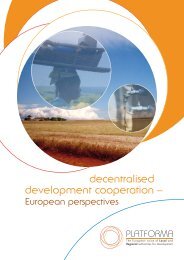
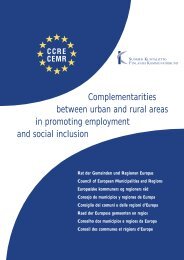

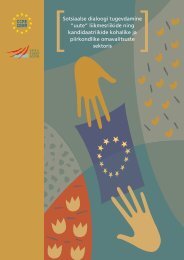
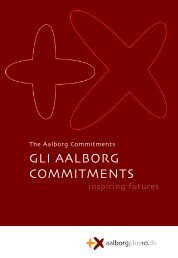
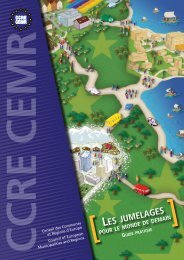
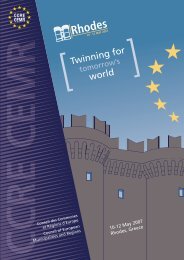
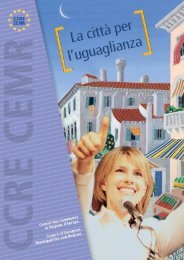

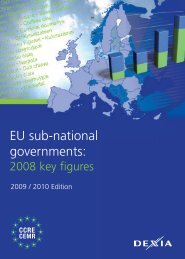
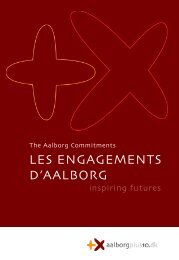
![[ ] Les jumelages pour le monde de demain](https://img.yumpu.com/29721946/1/190x96/-les-jumelages-pour-le-monde-de-demain.jpg?quality=85)

